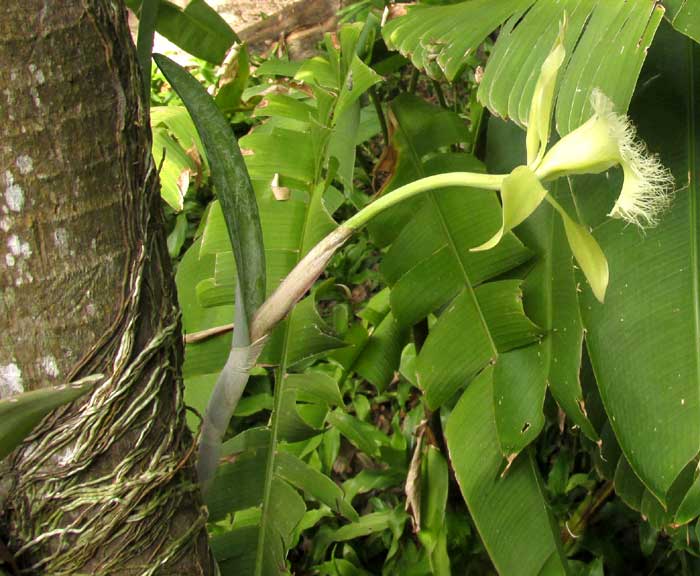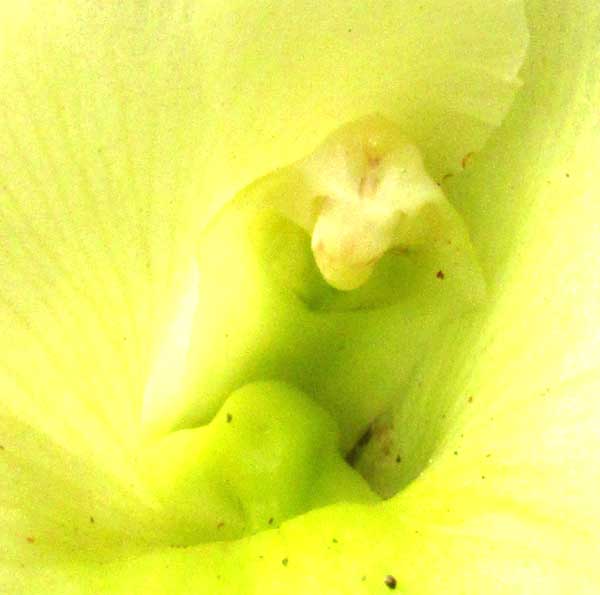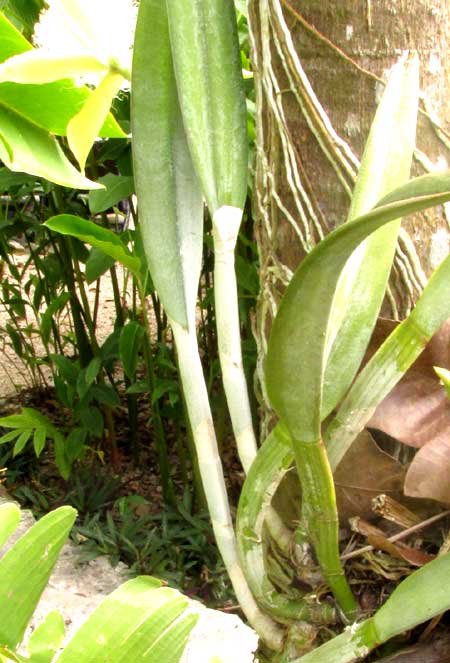Excerpts from Jim Conrad's
Naturalist Newsletter
from the February 1, 2019 Newsletter issued from Rancho Regensis north of Valladolid, Yucatán, MÉXICO;
elevation ~40m (~130 ft), N~20.876°, W~88.170°
RHYNCHOLAELIA (BRASSAVOLA) DIGBYANA

Some Canadian friends are retiring in Valladolid about 20kms south of the rancho, have bought a house there, and they invited me to come see their new home. Last week, in town for a new set of bifocals, I dropped by. Their address led to a door in an uninspiring wall looming above a narrow, broken-up sidewalk along a narrow, hot, dusty, potholed street.
Passing through the door, however, I entered a little paradise. It was cool and lushly green, mostly a garden with a fountain and pathways winding among tall trees, flowering bushes and ornamental ground-cover, and all kinds of potted plants, and vines, and ferns, bromeliads and orchids on tree trunks and among lower branches. Around the garden's perimeter buildings, some with entire walls opening into the garden, provided elegant living for my friends. During my guided tour a spectacularly flowering orchid rooted on a tree trunk caught my eye, the one shown atop this page.
That picture shows a good field mark for identifying tree-growing or epiphytic orchids in general, and that is the white roots adhering to but no parasitizing the trunk. The white, spongy, water-absorbing material covering the roots is called "velamen." Anatomically velamen can be thought of as a root's much modified, spongy epidermis. Its main purpose is to wick water from the air, but also it serves as insulation.
The most spectacular feature in the picture, however, is the large blossom with its white-hairy corolla lip. Below, you can see just how large the flower is compared to my hand:

Orchid floral anatomy is unique and can be hard to interpret. In that picture three of the long, narrow items extending outward are sepals, two are lateral petals, and the large, fringed item is the petal known as the lip. The lip curls around the "column," which is the Orchid Family's most unusual feature. It consists of male stamens and female style and stigmas all fused together. Below, you can see the column at the top of the lip's opening:

This orchid's stem and leaves also exhibited features important for identification, shown below:

Notice how the broad leaf blades at their bases abruptly connect with more slender sections, which themselves sprout from trunk-hugging, root-issuing stems. The slender sections immediately below the leaf blades are "pseudobulbs." During the dry season the blades may shrivel and fall off, leaving their pseudobulb behind. In many species the pseudobulbs are much larger than these and serve as water-storage reservoirs, and I'm guessing that these may do that as well.
All these details led to a cluster of orchid genera sometimes known as the Cattleya Alliance, Cattleya being an important genus. Our Valladolid species, easy to determine because of its spectacularly fringe-margined lip, currently is called RHYNCHOLAELIA DIGBYANA. However, that name has only recently been changed from Brassavola digbyana, and on the Internet mostly it's still called by that name. My old Bailey's Manual of Cultivated Plants refers to it as Laelia digbyana, so this species has been around.
Rhyncholaelia digbyana seems to have no good English name. It's native from southern Mexico (but not the arid Yucatan) south to Costa Rica. Despite its limited distribution, in the world of orchid-growing, it's thought of as an important species because it's so often used as a parent when producing hybrids with other species in the Cattleya Alliance. These hybrid offspring often turn out to be very vigorous growers with exceptionally large, fragrant blossoms. The general shape and fringed lip are dominant characters passed on to most hybrid offspring.
Rhyncholaelia digbyana is the national flower of Honduras.